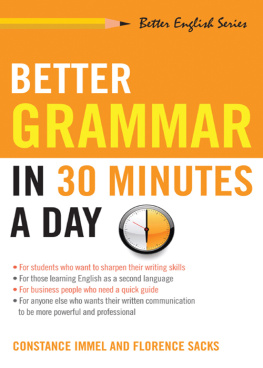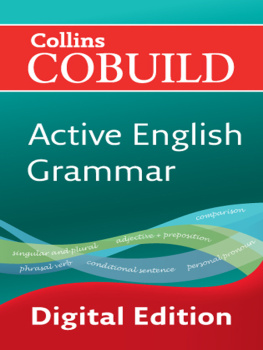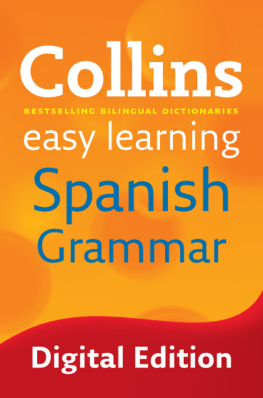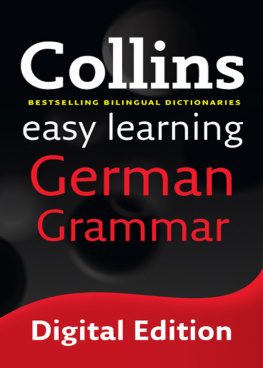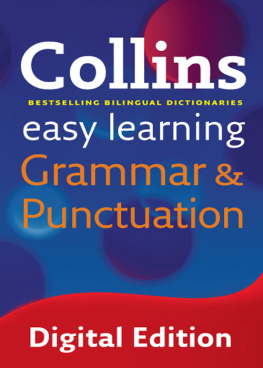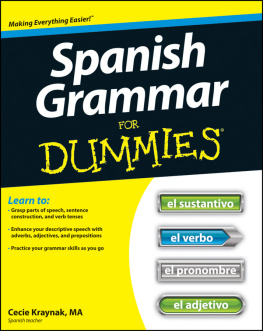
Better Grammar In 30 Minutes a Day
By
Constance Immel and Florence Sacks

Copyright 1994 by Harper Collins College Publishers Trade edition published 1995 by The Career Press, Inc.
All rights reserved under the Pan-American and International Copyright Conventions. This book may not be reproduced, in whole or in part, in any form or by any means electronic or mechanical, including photocopying, recording, or by any information storage and retrieval system now known or hereafter invented, without written permission from the publisher, The Career Press.
BETTER GRAMMAR IN 30 MINUTES A DAY
Cover design by The Visual Group
Printed in the U.S.A. by Book-mart Press
To order this title, please call toll-free 1-800-CAREER-l (NJ and Canada: 201-848-0310) to order using VISA or MasterCard, or for further information on books from Career Press.
Library of Congress Cataloging-in-Publication Data
Immel, Constance.
Better grammar in 30 minutes a day / by Constance Immel and Florence Sacks.
p. cm.
Includes index.
ISBN 1-56414-204-3 (paper)
1. English languageGrammarProblems, exercises, etc.
2. English languageGrammarSelf-instruction. I. Sacks, Florence. II. Title.
PE1112.3.I46 1995
428.2dc20
95-21103
CIP
Contents
Preface
Better Grammar In 30 Minutes a Day is a workbook for people who have something to say but have difficulty saying it in standard English. We believe that the clearly worded definitions and examples, together with a variety of exercises, can help those in writing courses, in English-as-a-second-language classes, and in writing laboratories and tutor-assisted classes. We also believe that anyone can use this book on their own to brush up on rusty grammar skills.
To help people write clear, error-free sentences, the book features:
Thorough coverage of key areas of grammar.
Clear explanations with a minimum of grammatical terms.
An abundant variety of exercises.
An answer key at the end of the book to encourage readers to work at their own pace and check their answers as they go.
We think that people learn best when they are actively engaged in the learning process. Therefore, we keep the explanatory material short, but we provide extensive examples and exercises that demonstrate the principle. Thus, readers are never faced with long, complicated explanations that are difficult to understand.
Many of the exercises are in paragraph form or contain sentences all on one topic. The topics are on subjects that should be of interest to anyone.
It is our hope that by using Better Grammar In 30 Minutes a Day, people will become competent writers by building their skills and confidence.
Constance Immel
Florence Sacks
Chapter 1
Nouns and Pronouns
1.1 Identifying Nouns
If you were asked to give some examples of nouns, you probably would respond with words like astronaut , Mars , or spaceship . You would be right, because a noun does name a person, a place, or a thing, but a noun can also refer to an idea such as truth or an activity such as orbiting . A noun, then, names a person, a place, a thing, an idea, or an activity.
If you are not sure whether a word is a noun, put the word the in front of it. If the word is a noun, in most cases, the phrase will make sense. In addition to the , some other common noun markers are a , an , these , those , that , and this . A noun marker is an adjective that points to the noun that follows it: a car, the Washington Monument, that routine.
Common and Proper Nouns
All of the examples in the previous paragraph except the Washington Monument are common nouns, which refer to people, places, things, ideas, or activities in general terms. Common nouns are usually not capitalized except at the beginning of a sentence.
However, when we refer to the name of a specific person, place, or thing, we use proper nouns, which always begin with capital letters. In general we do not capitalize the names of ideas or activities. Using the as a noun test will not always help you identify proper nouns, but remembering that they are capitalized will help you pick them out.
|
|---|
Common Nouns | Proper Nouns |
bridge | Vincent Thomas Bridge |
woman | Yvonne Burke |
street | Freshman Drive |
college | Metropolitan Community College |
Exercise 1.1
Using the noun test, identify the underlined words.
A. If the word is a noun, write N above the word.
B. If it is not a noun, write X above the word.

. The traffic on the highway stopped.
. Rain fell last night.
. Some drivers were cautious .
. The surface of the road was slick.
. Johns Buick had good brakes .
Do not be confused by other words in addition to the noun marker that may be in front of the noun. These words that describe or limit the noun are also called adjectives. For example:

Adjectives answer questions such as which or how many in reference to a noun.

Exercise 1.2
Using the noun test, identify all the nouns in these sentences. Write N above each noun.

Notice that the word cheese is not a noun in this sentence as it is in the sentence: Joe likes cheese . Angela is not eating plain cheese without any bread; she is eating a sandwich. Cheese tells us what kind of sandwich she is eating.
. Mr. Cuadros gave us two free tickets to the basketball game.
. Would you like a bowl of chicken soup and a fresh fruit salad?
. I bought a digital watch for thirty dollars at Kmart.
. Lori wore a new green wool dress to her job interview.
. The young doctor had a pleasant smile and a reassuring manner.
1.2 Singular and Plural Nouns
Use a singular noun when you are referring to only one person, place, thing, idea, or activity, and a plural noun when you are referring to more than one.
Noun Markers for the Singular
These words indicate that a singular word usually follows:
Next page
